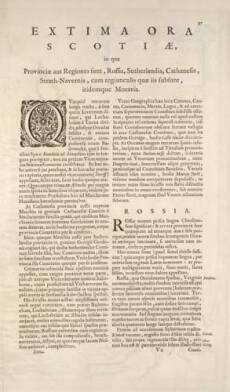Blaeu Atlas of Scotland, 1654
| Field | Content |
|---|---|
| Name: | Blaeu, Joan, 1596-1673 |
| Title: | Extima Ora Scotiae |
| Pagination: | 97 |
| Zoom view: | Click on the image to view in greater detail |
| 107 / 162 Scroll through pages: 


 | |
Translation of text:
THE FARTHEST SHORE OF SCOTLAND
in which are
the Provinces or Regions, Ross, Sutherland, Caithness,
Strathnaver, with their sub-regions,
and likewise Moray. (Section Note)
All the long stretch of lands from the gulf called Linnhe, which divides Lochaber from Lorne, as far as the Orkney Isles, and the farthest part of the mainland, including also Badenoch, which extends in length from the source of the River Spey to its downward course, was not so long ago classed under the name of the Sheriffdom of Inverness. To this city everyone looked for law, and in this city was the seat of the principal magistrate, whom our people call Sheriff, and this is still the case today: those also of the Hebrides which lie off these coasts in the vast areas of the sea, were under the same jurisdiction. This magistracy belonged by heredity to the Marquesses of Huntly.
But a recent Marquess withdrew from the province of Caithness in favour of the Earl of Caithness, of the family of Sinclair, who had married the sister of that Marquess, Joanna Gordon; from that union comes the present generation, and that province is classed as a county by itself.
The same Marquess also withdrew from his rights in the province of Sutherland in favour of his relation George Gordon, who had married the daughter and heiress of the Earls of Sutherland and thus gained this County and transferred it to his family. Hence today that province also is classed as a county by itself.
The small city of Cromarty, on the gulf of the same name, with a little part of the near-by land, was held from olden times as a sheriffdom; the prefecture still pertains to the family of Urquhart (the head of this family has a castle and estate in the vicinity of the town).
When these are removed, it still remains the largest county of the whole kingdom, for apart from Badenoch, Lochaber, that isthmus of lands which lies between Lochaber and the Hebrides, held by many lesser chiefs, and all those islands which are scattered here and there along the coast, it comprises the whole of Ross with its neighbouring or included sub-regions, Strathnaver, Assynt, and the surroundings of Loch Ness.
The ancient geography claims that these places were occupied by Creones, Cantae, Carnonacae, Mertae, Logi, and in the extreme north Cornabii; of all of these there is no memory in Scottish writers or in foreign ones, unless perhaps obscure traces of the Cornabii are hidden in the castle of the Earls of Caithness, which not so long ago was called Gernigo, though today it is beginning to be called Castle Sinclair. But the ocean which lies against great areas of the lands, beginning on the left at the promontory of Taezalum, now called Buchan Ness, and on the right at the promontory of Veruvium, now Duncansby Head, penetrating as far as Inverness and more deeply to the monastery of Beauly, formerly named the estuary of Varar, now the Moray Firth, seems not yet to have disposed of antiquity; for in the innermost recess of the gulf, three rivers with different names join together under the name of the River Farrar and come into that great estuary of Varar.
ROSS
The name Ross in the old language means peninsula; and in truth this province, although it reaches to both seas, yet is pierced on both sides by many gulfs of the intruding ocean, and if one looks at it as a whole, includes frequent peninsulas.
All these gulfs (as it will be sufficient to say once) are named throughout the whole kingdom by those who speak in the old language ‘lochs’; and because of the ambiguity of the word, they call gulfs of the sea salt lochs, and the landlocked ones fresh.
Ross, where it looks west, facing the Vergivian Ocean, is cut by many gulfs, all of which abound in a rich harvest of fish (especially huge shoals of herring). However the whole country rises in harsh mountains; it is not rich in grain, as there are not sufficient plains, but has much woodland, and is more suited to pasture than crops. But the lack of grain is lightened by an abundance of domesticated animals and game, which is sent hence every year and distributed far and wide. The first area to the south-west is called Kintail, which is divided by a narrow strait from the island of Skye, and under it is the sub-region Glen Elchaig; this is the ancestral and patrimonial land of the distinguished


